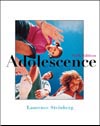 |
1 |  | 
According to the popular media, serious differences exist between the values of adolescents and their parents; this is referred to as the . |
 |
 |
2 |  | 
Among the 25% of families who report difficulty during adolescence, about had problems before the child entered adolescence. |
 |
 |
3 |  | 
Compared to previous generations, parents tend to be today when their children enter adolescence. |
 |
 |
4 |  | 
During adolescence, children assert themselves with their parents (e.g., interrupting more during conversations), but parents resist such power struggles. |
 |
 |
5 |  | 
Parents who resist allowing teens to gain influence in the family are more likely to experience problems such as . |
 |
 |
6 |  | 
Diminished between parents and children is often reflected in increases in privacy taken by the adolescent, as well as less frequent physical affection. |
 |
 |
7 |  | 
Relationships have a influence: parenting behaviors influence children, which influence parenting styles, etc. |
 |
 |
8 |  | 
is the degree to which a parent is accepting and supportive of a child's needs. |
 |
 |
9 |  | 
Teens raised by parents are more responsible, self-confident, adaptive, creative, curious, and have higher social and academic skills than other teens. |
 |
 |
10 |  | 
Teens raised by parents are more impulsive and exhibit delinquent behavior more than others. |
 |
 |
11 |  | 
Engaging children in helps develop the intellectual ability of the child. |
 |
 |
12 |  | 
parenting is more common among minority group families; but it does not seem to have negative effects on children. |
 |
 |
13 |  | 
In families where teens are allowed to express themselves without judgment, adolescents develop higher . |
 |
 |
14 |  | 
Studies in examine twins who are identical and non-identical (fraternal), and also compare siblings who were adopted into different families. |
 |
 |
15 |  | 
are factors that siblings experience about equally, and thus make them similar. |
 |
 |
16 |  | 
are unique experiences that make siblings different. |
 |
 |
17 |  | 
Exposure to marital is predictive of healthy vs unhealthy adolescent development. |
 |
 |
18 |  | 
Apparent inconsistencies between different studies are more common when the is small. The effect size is the difference between two groups being compared in one study. |
 |
 |
19 |  | 
A statistical procedure called is used to combine the results of different studies, thus "summarizing" the results and providing a clearer picture of the nature of the issues and characteristics in question. |
 |
 |
20 |  | 
, which strive to restrict the child's exposure to neighborhood dangers, have positive effects on child development, as long as they are not excessive. |
 |



 2002 McGraw-Hill Higher Education
2002 McGraw-Hill Higher Education